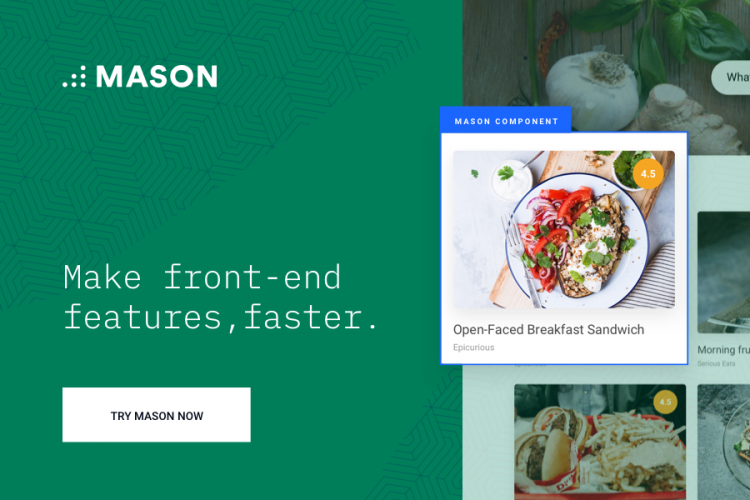
Building a front-end for your site from scratch might be the hardest part of building a great web app. The idea and logic can be perfect, but if the user interface is a wreck, you’ll never be a success. That’s where tools like Mason’s front-end-as-a-service become so valuable. With Mason, you can visually build a front-end for your website with no coding required, simplifying the process of construction and vastly accelerating the deployment timescale.
The Value of a Front-End as a Service
Mason allows you to create clean, attractive, functional front-ends for your websites using a creative and functional site building application. You can manage the complete front end experience in your codebase, all with no extra coding required. This way of building empowers your team to work collaboratively to solve design challenges more swiftly and effectively. As a front-end building platform, Mason enables all of this.
All of the interfaces designed with Mason hook into your own backend APIs. All of Mason’s code is abstracted down to one line, with dynamically generated CSS and HTML sheets. Mason maintains the code for your team, making sure any user can propagate changes instantly without the need for coding and redeployment.
No one wants to code an entire website from scratch. That kind of design went out with the bad old days of CSS 1. While some designers have always maintained an insistent and outdated opinion that what-you-see-is-what-you-get tools are basically for sissies, any smart developer knows it’s more important to work smart than to work hard. You should use all the tools that are available to you, which includes WYSIWYG editors, building blocks, templates, and other tools.
Mason is a unique kind of front end builder. It’s not simply a CSS framework like Basecamp. Instead, it’s a programmatic way for you to build a visual interface from scratch with no need for coding. The system is built for backend designers, so you’ll find plenty of detailed options and total control over the created systems. You won’t feel like you’re out of control when the system makes some dumb decision for you. Instead, you’ll be kicking yourself for coding in such a dumb decision. Really, it’s a better world.
Building A User Interface with Mason
Mason’s design philosophy is based on breaking down what they call the “monolithic” front-end that’s built from scratch for each project. By deconstructing the front-end into a series of modules, Mason can apply a modular approach to design and implementation of the front end. With a carefully designed system, a central location could manage all design elements, employing front-end building blocks to modularly structure a website to your exact specifications. This conjuring might sound like magic, but it’s what Mason does best.
Building a front-end in Mason relies on a drag-and-drop interface. This type of interface has always been ideal for creating any sort of visual layout. The most obvious, intuitive design process is sticking pieces where you want them. So while some crusty Linux nerds might raise their noses at a graphical drag-and-drop interface for designing a front end, the rest of us can get a leg up on the Luddites and actually use the thing. It’s impressively well-designed, reminding us of Squarespace’s top-of-the-line website building tools.
The tools are smartly designed and can be used precisely. A layer system allows for a sophisticated arrangement of elements both visually and semantically. The structure can be manipulated with both the drag-and-drop functionality and detailed tools, allowing you to set CSS rules, script hooks, and other attributes.
Inheritance rules from CSS apply, making visual design simpler by slotting into a design metaphor that you’re already familiar with. This combines the convenience of the drag-and-drop layout tools with the power and procession of CSS rules like flexbox, grid, and height/width settings, providing a robust a dynamic toolset that can solve nearly any problem.
Mason’s builder is easy to navigate and understand, and UI elements interact in a way you’d expect them to. With a very basic understanding of the language of an interface, you can start designing in Mason without any training at all. Just explore the intuitive interface for a few minutes, and you’ll quickly understand what the software enables you to do. This kind of interface design is as rare as it is worth praising, and we’re excited to see it in Mason. It improves the experience of using the system dramatically, making what could be a chore into something charming and even delightful—dare I say fun?
Connecting Your API
If all this design didn’t connect to your codebase, it would be worthless. As a result, connections between your codebase and Mason are robust and simple to establish. They’re durable enough to survive a redesign too, making your life easier in more ways than one.
With Mason’s available tools, you can connect UI elements to your backend code with a few dropdown boxes. This graphic interface drastically simplifies the process of executing the API, potentially accelerating deployment.
Conclusion
Mason can dramatically speed up your development cycle, allowing front-end changes to take place at the speed of a click, producing a better experience for your users and a better return on your investment.
Author: Alex Fox